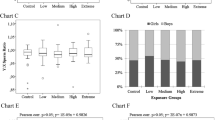Abstract
In order to rule out the possibility of omitting some individuals in the study at field visits described in previous articles, either because of the reluctance of the subject or because of his appointment elsewhere, fertility and infertility states of borate workers of the Borax and Acid Plants in Bandirma, Balikesir are given. Balikesir is one of the four provinces with large borate deposits of Turkey, and Bandirma is 1 of its 19 districts. This county is relatively far away from borate deposits, and drinking water piped out through the springs has a boron amount between 0.10 and 0.82 ppm B. That the participants are occupationally exposed to the mineral in essence is therefore conceivable. At the first phase of the investigation, 191 workers were interviewed, as detailed previously. Among these, there were six infertiles of the primary type with a rate 3.1%. Boron-unrelated infertile couples among sibs were found to be 2.6–3.6%, and 3.2% for three-generation marriages—none being higher than those revealed in different sets of controls. In the second stage of work, computerized files of all workers of the facility and all employees of the general management sharing the same location were checked without an interview. Twenty-four subjects (3.4%) out of 712 workers were childless versus 2.7% among 108 employees, and 2.2% among 91 workers of a distantly located sulfuric acid plant of the same complex. The differences were not significant, and these recent findings support the conclusion already reached almost unambiguously that boron exposure at the present levels does not interfere with human reproduction.
Similar content being viewed by others
References
Anonymous, Health effects of boron, Environ. Health Perspect. 102 (Suppl. 7), 150 (1994).
World Health Organization, Trace Elements in Human Nutrition and Health, World Health Organization, Geneva (1996).
C. D. Hunt, Regulation of enzymatic activity. One possible role of dietary boron in higher animals and humans, Biol Trace Element Res. 66, 205–225 (1998).
F. H. Nielsen, The justification for providing dietary guidance for the nutritional intake of boron, Biol. Trace Element Res. 66, 319–330 (1998).
N. Y. Tarasenko, A. A. Kasparov, and C. M. Strongina, Effect of boric acid on the generative function in males, Giginea Truda i Professionalnye Zabolevaniya 11, 13–16 (1972).
G. N. Krasovskil, S. P. Varshavskays, and A. L. Borisov, Toxic and gonadotropic effects of cadmium and boron relative to standards for these substances in drinking water, Environ. Health Perspect. 13, 69–75 (1976).
S. A. Hubbard, Comparative toxicology of borates, Biol. Trace Element Res. 66, 343–357 (1998).
M. D. Whorton, J. L. Haas, L. Trent, and O. Wong, Reproductive effects of sodium borates on male employees: birth rate assessment, Occup. Environ. Med. 51, 761–767 (1994).
B. S. Şayli, E. Tüccar, and A. H. Elhan, An assessment of fertility in boron-exposed Turkish subpopulations, Reprod. Toxicol. 12, 297–304 (1998).
B. S. Şayli, An assessment of fertility in boron-exposed Turkish subpopulations: 2. Evidence that boron has no effect on human reproduction, Biol. Trace Element Res. 66, 409–422 (1998).
B. S. Şayli, An assessment of fertility and infertility in boron-exposed Turkish subpopulations: 3. Evaluation of fertility among sibs and in “borate families”, Biol. Trace Element Res. 81, 255–276 (2001).
C. Helvaci and R. N. Alonso, Borate deposits of Turkey and Argentina. A summary and geological comparison. Turk. J. Earth Sci. 24, 1–27 (2000).
J. G. Penland, Dietary boron, brain function, and cognitive performance. Environ. Health Perspect. 102 (Suppl. 7), 65–72 (1994).
S. L. Meacham and C. D. Hunt, Dietary boron intakes of selected populations in the United States, Environ. Health Perspect. 102(Suppl. 7), 66, 65–78 (1998).
M. T. Mungan, Personal communication.
M. V. Pahl, B. D. Culver, P. L. Strong, F. J. Murray, and N. D. Vaziri, The effect of pregnancy on renal clearance of boron in humans: a study based on normal dietary intake of boron, Toxicol. Sci. 60, 252–256 (2001).
B. Sutherland, P. Strong, and J. C. King, Determining human dietary requirements for boron, Biol. Trace Element Res. 66, 193–204 (1998).
Author information
Authors and Affiliations
Rights and permissions
About this article
Cite this article
Şayli, B.S. Low frequency of infertility among workers in a borate processing facility. Biol Trace Elem Res 93, 19–29 (2003). https://doi.org/10.1385/BTER:93:1-3:19
Received:
Revised:
Accepted:
Issue Date:
DOI: https://doi.org/10.1385/BTER:93:1-3:19




